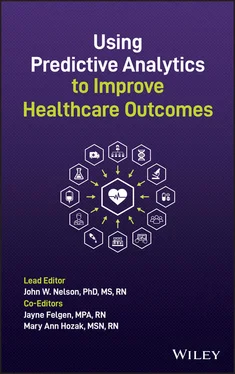Using Predictive Analytics to Improve Healthcare Outcomes
Здесь есть возможность читать онлайн «Using Predictive Analytics to Improve Healthcare Outcomes» — ознакомительный отрывок электронной книги совершенно бесплатно, а после прочтения отрывка купить полную версию. В некоторых случаях можно слушать аудио, скачать через торрент в формате fb2 и присутствует краткое содержание. Жанр: unrecognised, на английском языке. Описание произведения, (предисловие) а так же отзывы посетителей доступны на портале библиотеки ЛибКат.
- Название:Using Predictive Analytics to Improve Healthcare Outcomes
- Автор:
- Жанр:
- Год:неизвестен
- ISBN:нет данных
- Рейтинг книги:5 / 5. Голосов: 1
-
Избранное:Добавить в избранное
- Отзывы:
-
Ваша оценка:
- 100
- 1
- 2
- 3
- 4
- 5
Using Predictive Analytics to Improve Healthcare Outcomes: краткое содержание, описание и аннотация
Предлагаем к чтению аннотацию, описание, краткое содержание или предисловие (зависит от того, что написал сам автор книги «Using Predictive Analytics to Improve Healthcare Outcomes»). Если вы не нашли необходимую информацию о книге — напишите в комментариях, мы постараемся отыскать её.
Discover a comprehensive overview, from established leaders in the field, of how to use predictive analytics and other analytic methods for healthcare quality improvement. Using Predictive Analytics to Improve Healthcare Outcomes
before
proven in advance
Using Predictive Analytics to Improve Healthcare Outcomes
Using Predictive Analytics to Improve Healthcare Outcomes — читать онлайн ознакомительный отрывок
Ниже представлен текст книги, разбитый по страницам. Система сохранения места последней прочитанной страницы, позволяет с удобством читать онлайн бесплатно книгу «Using Predictive Analytics to Improve Healthcare Outcomes», без необходимости каждый раз заново искать на чём Вы остановились. Поставьте закладку, и сможете в любой момент перейти на страницу, на которой закончили чтение.
Интервал:
Закладка:
Sociotechnical Systems Theory
When studying the experience of the work of nurses, or any employee who works directly with patients, it is important to consider the ease or difficulty of operations for enacting care. The study of operations includes theories to help guide the development of research, methods to measure success, and interpretation and application of findings to achieve operational improvements. Sociotechnical systems (STS) theory proposes that both social and technical aspects of operations contribute to the experience of work (Trist & Bamforth, 1951; Trist & Emory, 2005). It has been established that while good equipment and resources are essential to carry out the technical aspects of the work, relationships contribute at least as much as the technical aspects of work to a productive and enjoyable work experience (Trist & Bamforth, 1951; Trist & Emory, 2005).
Misaligned, stressed, or missing relationships can impede productivity just as surely as poor equipment or resources can, which is consistent with concepts of pause and flow proposed in constructal theory (Bejan, 2019; Bejan & Zane, 2012). Bejan and Zane (2012) quote Michelangelo as saying, “Design is the root of all sciences” (p. 827). This ancient principle applies to the science of care delivery, both in how care is delivered by teams and how it is supported within systems. Constructal theory provides a theoretical framework with which to study the design of care, including the flow of work that results in enjoyment and productivity.
Frameworks of Care
It is important to distinguish a theory of caring from a framework of care. Typically a framework of care is based on one or more caring theories. What makes a framework different is that it includes a methodology for the theory to take hold in all of the structures, processes, policies, and people in an organization. A framework of care is designed to see to it that a theory of care, with its concomitant behaviors, becomes pervasive throughout a system. As mentioned, the two frameworks discussed in this book are Relationship‐Based Care (RBC) and the Caring Behaviors Assurance System (CBAS).
Relationship‐Based Care (RBC) is a framework of care with eight dimensions:
1 Patient and Family (in the center of everything)
2 Healing Cultures
3 Leadership
4 Teamwork
5 Interprofessional Practice
6 Care Delivery
7 System Design
8 Evidence
Like many frameworks of care, RBC engages staff councils in embedding its principles into the structures, processes, policies, and people in the organization. Most of the case studies in this book were carried out in organizations that practice RBC. Operationalization of the RBC model uses the powerful formula for change outlined in the book I 2 E 2 : Leading Lasting Change (Felgen, 2007) as it is key to a successful transformation. Appendix Boffers a description of the I 2 E 2formula.
Another framework of care, which is reviewed at length in the international section of this book, is the Caring Behaviors Assurance System (CBAS). CBAS has six dimensions, which are based on the “7 Cs” derived from a 2010 paper published by the Scottish government, called The Healthcare Quality Strategy for NHSScotland [sic]. You will see that two of the 7 Cs are combined in the first dimension:
1 Care and Compassion
2 Communication
3 Collaboration
4 Clean Environment
5 Continuity of Care
6 Clinical Excellence
The chief difference between RBC and CBAS is that the CBAS framework seeks cultural change entirely through the implementation of behavioral changes for staff members. It is a framework, rather than a theory, because, like RBC, it engages staff members in embedding these behavioral changes in the structures, processes, policies, and people in the organization.
Unlike RBC, CBAS has an extensive method of measuring the degree to which the concepts of caring are taking hold in practice, employing three separate measures, including an assessment of how job satisfaction is being impacted by its implementation. Having a rigorous method of measurement specified for a framework of care helps advance and sustain the framework of care in several ways. It identifies (a) what specific components of the framework can be shown to relate to improved outcomes, (b) what components of the framework are critical for staff members to embrace in order to enact the framework of care, and (c) where the important components of the framework are working well within the organization and where they need additional support. The measurement process for CBAS accomplished all of these things. Implementation of CBAS in 18 hospitals in Scotland is reviewed in detail in Chapter 18.
There are several frameworks of care that are not included in this book but are reported in the literature. Sometimes frameworks are adopted in name only or amended dramatically for specific contexts. For example, the term patient‐centered care is a general term proposed by the Institute of Medicine (IOM), which it defines as “providing care that is respectful of, and responsive to, individual preference, needs, and values, and ensuring that patient values guide all clinical decisions” (IOM, 2001, p. 5). This term is applied to a wide variety of models developed for specific organizations. Examples include the Cleveland Clinic's use of the IOM definition to create its own organization‐specific patient‐centered framework of care (Smith, 2018). Some companies have helped implement specific frameworks also termed patient‐centered care. For example, Planetree has a number of methods to help organizations implement and become certified in a framework of patient‐centered care (Planetree, 2020). Livestrong, a nonprofit organization which provides support for people with cancer, worked with the consulting firm Upstream to develop yet another framework of patient‐centered care (Upstream, 2020). And finally, the Health Education of England (HEE), an agency within the National Health Service (NHS) of England, provides support to implement what it also calls patient‐centered care (HEE, 2020).
Some theorists assert that Watson's Theory of Transpersonal Caring (2008a) is a framework of care when the processes of caring behaviors are taught with the intention that they be carried out within operations of care. While the implementation of any processes of caring in the absence of structures, processes, and policies to support the sustaining of the behaviors cannot be called a framework of care, the implementation of Watson's caring behaviors is an integral part of several frameworks of care delivery.
RBC's Four Decades of Wisdom
Later in this book, as case studies are presented in which people working in Relationship‐Based Care cultures have had success in using predictive analytics to improve outcomes, they often credit the success of the project—or even the very existence of the project—to what they have learned while implementing RBC. Often, what they credit, however, is some of the long‐honed wisdom baked into the process of implementing RBC that is not readily apparent in the dimensions of the model itself. You will see references to responsibility + authority +accountability (R+A+A), Primary Nursing, the importance of clarity, and more. In order to help you better understand those concepts when you meet them in your reading, here is a summary of each concept.
The Three Key Relationships in Relationship‐Based Care
The most central tenet in Relationship‐Based Care is that every relationship matters. Therefore, it is essential that all people in the organization tend to the quality of their relationships with themselves (self‐awareness), with their colleagues, and with patients and families. Many discussions of these three relationships also focus on “care of” self, colleagues, and patients and families.
Читать дальшеИнтервал:
Закладка:
Похожие книги на «Using Predictive Analytics to Improve Healthcare Outcomes»
Представляем Вашему вниманию похожие книги на «Using Predictive Analytics to Improve Healthcare Outcomes» списком для выбора. Мы отобрали схожую по названию и смыслу литературу в надежде предоставить читателям больше вариантов отыскать новые, интересные, ещё непрочитанные произведения.
Обсуждение, отзывы о книге «Using Predictive Analytics to Improve Healthcare Outcomes» и просто собственные мнения читателей. Оставьте ваши комментарии, напишите, что Вы думаете о произведении, его смысле или главных героях. Укажите что конкретно понравилось, а что нет, и почему Вы так считаете.












